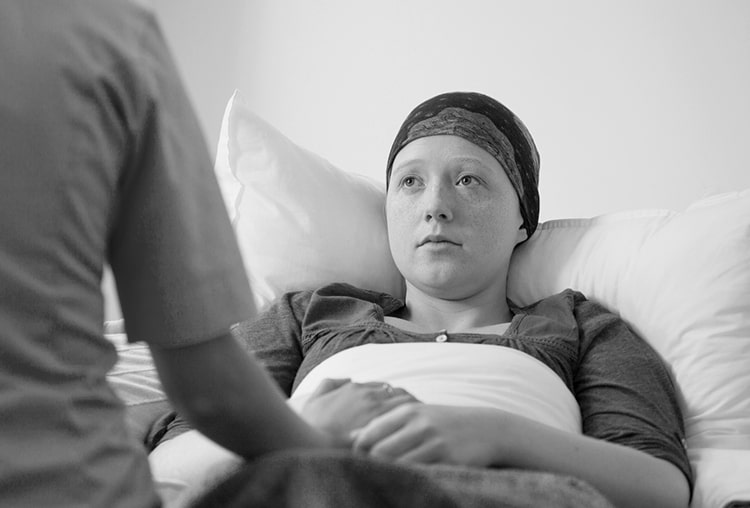
After active cancer treatment options have been exhausted, patients diagnosed with cancer may want to consider hospice care during the final days, weeks or months of life. Hospice for cancer treatment considers the unique needs of cancer patients, provides compassionate care, and helps maintain a patient’s quality of life during the final stages of terminal cancer.
Fill out below to receive an informational diagnosis guide
When To Consider Hospice Care for a Cancer Patient
While many families put off discussions about hospice care until cancer has progressed past the active cancer treatment phase, discussing the idea early during active cancer treatment often helps family members prepare for the possibility in advance.
One thing to remember is that the question isn’t ‘how long do cancer patients live in hospice’ because hospice care isn’t a specific place or prescribed course of action. Hospice care is a philosophy of care focused on the quality of life for the advanced cancer patient.
Here are some signs that it might be time to consider hospice:
- The malignant tumor has progressed to a point where treatment is ineffective
- The patient has decided to stop treatment after a specific point
- The burden of care has become too difficult for family members to manage on their own
Eligibility Requirements for Cancer Patients To Receive Hospice Care
The primary guideline for hospice care eligibility is a life expectancy of six months or less. For end-stage cancer patients, hospice care is typically recommended when curative treatment has been discontinued, and the patient’s functional status has declined to a level where regular, consistent assistance is necessary to carry out activities of daily living.
Hospice care is available for cancer patients with a wide range of diagnoses. Patients with lung, prostate, breast, and other malignant cancers may be eligible for hospice care. If a cancer patient has another severe concurrent illness, the hospice cancer care plan may include management of both the effects of cancer and other symptoms caused by the co-occurring illness.
A clinical oncology professional can assess the cancer patient for functional status using formal assessments such as the Palliative Performance Scale and the Eastern Cooperative Oncology Group scale. A physician may use these scales to make a hospice recommendation, or the discussion may be initiated by family members who notice specific behaviors and symptoms exhibited by the patient at home.
Some indicators that a patient may be ready for hospice care services include:
- Being bedbound or spending more than 50% of their time in bed or seated in a single room during the day
- Displaying obvious cancer symptoms
- Unable to perform self-care activities, such as bathing, eating and grooming
- Unable to work or perform everyday activities, such as cooking and cleaning
- Having a reduced nutritional intake due to loss of appetite or inability to eat effectively
While hospice care is intended for cancer patients who’ve ceased treatment for a terminal illness, some patients who are continuing treatment may be eligible for palliative care. A palliative care program is designed specifically for those who wish to continue medical treatment but have difficulty caring for themselves or participating in the activities of daily living.
Someone receiving chemotherapy might get assistance with daily activities, services to improve the patient’s quality of life and medication management for symptom relief. The palliative care team works with the primary caregiver and cancer care team to determine appropriate services and create an individualized plan to meet the patient’s needs. A patient participating in clinical trials for cancer treatment may also be eligible for palliative care.
Where Hospice Services Take Place
Hospice and palliative care organizations provide services at the place where the patient lives. This might be the patient’s home, a family member’s, or an assisted living facility. Sometimes, hospice services may be available in a nursing home or medical facility during a temporary hospital stay. One goal of hospice is to make the patient comfortable during the very end of life stage, and helping the patient stay in a familiar setting can be part of this.
Hospice care providers visit the patient’s home regularly, and different hospice care team members may schedule visits on different days of the week.
How Hospice Care Helps Family Members Care for a Cancer Patient
Family caregivers work with a patient’s doctors and hospice team members to provide the best care for their loved one. Upon admission to a hospice care program, the hospice doctor evaluates the patient and develops an individualized care plan. A team of hospice care professionals might include a nurse, a social worker, a home health aide, physical or occupational therapists, a clergy member and hospice volunteers.
Some ways cancer hospice care and palliative care can help cancer patients and their families include:
Three Oaks Hospice Locations
Three Oaks Hospice has locations across the U.S., ensuring that caring, compassionate hospice and palliative care are available to patients where they live. Three Oak Hospice provides on-site care in the home or where the patient calls home, whether that’s in their residence, a family member’s, or in a medical facility.
Choosing a Hospice and Palliative Care Organization
A good hospice and palliative care organization works with the patient’s oncologist and primary care physician to develop a comprehensive care plan during cancer treatment. Medicare, Medicaid and most private health insurance cover hospice care.
There are many benefits to entering a hospice program for end-of-life care after an advanced cancer diagnosis. Some reasons to choose hospice include:

Professional Clinical Support
From caregiver education to medical monitoring, hospice teams provide the expert support families need to effectively care for a cancer patient at home.
Improved Quality of Life
Patients in hospice care have a better quality of life because basic needs are met and stress is reduced. Hospice patients also have a reduced rate of rehospitalization because pain and other symptoms are managed at home.


Peace of Mind
Families of patients in hospice can feel confident that their loved one is being cared for even when they aren’t present. One-on-one support and 24-hour access to services ensures consistent care.









